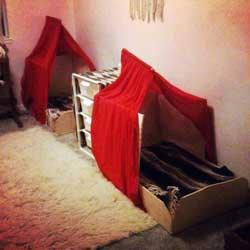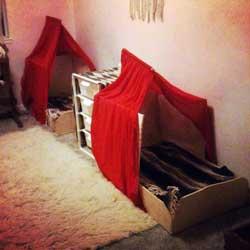Much too often sleep is an under-rated process in child care circles. It is readily accepted that children don’t like to sleep, and are allowed not to sleep. Chronically sleep-deprived children are in abundance these days! I believe that sleep is just as important as healthy food. One would never even consider not feeding a child in one’s care lunch, but all too often naps are skipped. When children transition into my care I always talk to the parents about the sleeping routines at home. Most children that come into my care do not know how to go to sleep on their own. We work very hard with children to support them through this process of learning how to go to sleep without intervention. It’s always a different process for each child, depending on their patterns of behavior from home. It doesn’t usually take more then a couple of weeks for the children to figure this out. Because our routines are so transparent, they see what each of the other children is doing and what is happening, and then they want and do the same.
Much too often sleep is an under-rated process in child care circles. It is readily accepted that children don’t like to sleep, and are allowed not to sleep. Chronically sleep-deprived children are in abundance these days! I believe that sleep is just as important as healthy food. One would never even consider not feeding a child in one’s care lunch, but all too often naps are skipped. When children transition into my care I always talk to the parents about the sleeping routines at home. Most children that come into my care do not know how to go to sleep on their own. We work very hard with children to support them through this process of learning how to go to sleep without intervention. It’s always a different process for each child, depending on their patterns of behavior from home. It doesn’t usually take more then a couple of weeks for the children to figure this out. Because our routines are so transparent, they see what each of the other children is doing and what is happening, and then they want and do the same.
In my home program I have the privilege of having space for a separate nap room from the play area. The space I use was designed as a “formal dining room” in our house, but since I only have one set of table and chairs in this house, that room got doors attached, it got lazured, and is now a room with 6 and sometimes 7 little beds in it. Most of the children in my care sleep in that room. A few children—if they are very light sleepers, or have to go through a more vocal process before sleeping—sleep in an extra bedroom that holds a few cribs. Infants who are not yet mobile sleep in prams which can either be parked in a nap room or outside under a tree while we play outside.
Most of the children in my Infant Program take only one nap a day, right after lunch. Sometimes the younger children have two naps that fall on either side of the larger nap group, and the tiny infants sleep on demand and don’t usually have a rhythm yet. I go through a routine with each child for sleeping.
 The routine for the once-a-day nappers is the following: After we eat a hot lunch (which I prepare for them), we give the children about a half-hour to play, either inside or on the deck. We do not open up the whole yard for them. This play time gives them a chance to empty their bowels. There is nothing more frustrating for the child than having a nap shortened because of a bowel movement! The caregiver then prepares the nap room by closing the curtain and closing the doors. Once the diapers are changed, a book is chosen by the child or a bottle has been prepared. Then we sit together, the two of us, in the rocking chair. Attention is focused only on the child. It’s good to have another caregiver who can watch the others. We sing “Wee Willy Winkie” and then the book is read. Some of the children get a bottle offered and no book. When the bottle is dry, or the book is done, the child and I say good night to the other children in the room with a little wave of the hand to each. Then the child is put down and walks with the caregiver to their bed with a little song: “Good night (child’s name), good night (child’s name), good night (child’s name). I’ll see you when you wake.” They are tucked in. The door is closed and the next child has a turn. After knowing the children for a while, we have an order for going down for nap. We also don’t have more then two awake children in the nap room at any time. If there are two children going to sleep, then we wait until at least one is asleep before bringing the next in. This way we get 6 or 7 children all in the same room sleeping. It takes us about an hour to do this.
The routine for the once-a-day nappers is the following: After we eat a hot lunch (which I prepare for them), we give the children about a half-hour to play, either inside or on the deck. We do not open up the whole yard for them. This play time gives them a chance to empty their bowels. There is nothing more frustrating for the child than having a nap shortened because of a bowel movement! The caregiver then prepares the nap room by closing the curtain and closing the doors. Once the diapers are changed, a book is chosen by the child or a bottle has been prepared. Then we sit together, the two of us, in the rocking chair. Attention is focused only on the child. It’s good to have another caregiver who can watch the others. We sing “Wee Willy Winkie” and then the book is read. Some of the children get a bottle offered and no book. When the bottle is dry, or the book is done, the child and I say good night to the other children in the room with a little wave of the hand to each. Then the child is put down and walks with the caregiver to their bed with a little song: “Good night (child’s name), good night (child’s name), good night (child’s name). I’ll see you when you wake.” They are tucked in. The door is closed and the next child has a turn. After knowing the children for a while, we have an order for going down for nap. We also don’t have more then two awake children in the nap room at any time. If there are two children going to sleep, then we wait until at least one is asleep before bringing the next in. This way we get 6 or 7 children all in the same room sleeping. It takes us about an hour to do this.
The children that don’t fit into this rhythm of one nap a day after lunch are observed carefully to watch for low energy and signs of tiredness, then asked if they are ready for a nap (and believe it or not the answer is usually Yes! And if it’s No, then we might give them five minutes, and then we say it’s time). We do a diaper change, rub lavender oil on their hands, offer a bottle and sit in the rocking chair for a bit. We say good night to each child in the room and then it’s off to bed with the same sleeping song.
These routines work amazingly well, and all the children have adjusted to this—to the great amazement of their parents! Sometimes we have to send a caregiver into the nap room to lie down on the floor for a bit, but never for very long. Sometimes it has happened that a child has to be moved to a more private room if finding rest is too difficult, but again, this happens only very seldom. Naps usually last for at least two hours and most often, three. We do allow pacifiers or transitional items for nap if they are brought from home. Some children sleep in cribs or port-a-cribs, and some in little beds that I made. Here are some pictures of the nap space.
